 |
| The buttons read: "I <3 Oregon beers" and "Oregon gives me wood" (from the Laurelwood Brewery in Portland) |
Ching Ching by Bend Brewing, Bend, Oregon
Style: Sour with hibiscus and pomegranate
Notes: Pinky/orange color...simply amazing!
ABV: 9.5% (watch out)
Flemish Kiss by The Commons Brewery, Portland, Oregon
Style: "Bread" ale/pale ale
Notes: Slightly sour (just a hint!), lemony, fresh
ABV: 5.7%
The Stoic by Deschutes, Bend, Oregon
Style: Belgian quadruppel
Notes: Smells like a sour but finishes like a sweet Trappist
ABV: 11% (monastic strength)
Urkontinent by Dogfish Head, Milton, Delaware
Style: Belgian dubbel
Notes: Smells like coffee; brewed with rooibos tea
ABV: 8%
Red and White by Dogfish Head, Milton, Delaware
Style: Belgian wit
Notes: Sour and light, wine-y (aged in Pinot Noir barrels), really drinkable
ABV:10%
Abbey's Ale by Seven Brides, Silverton, Oregon
Style: Belgian quadruppel
Notes: A sour quad! Super drinkable, not puckering -- my favorite of the night! I had seconds (and I wasn't the only one...)
ABV: ??
Cockeye Cooper by Uinta, Salt Lake City, Utah
Style: ??
Notes: Light, cherry. Strong flavor but really unique. Delicious.
ABV: 11%
Diamond Kings by Brugge Brasserie, Indianapolis, IN
Style: Belgian quadruppel
Notes: Ages in Cabernet barrels -- tastes heavenly!
ABV: ??
Also of note...
Everything crazy and experimental by Short's, all the tart and tangy fruit beers by Rocky Mountain Brewing in Colorado Springs (think New Glarus' Raspberry Tart, but better), and Laughing Dog's Anubis imperial coffee porter.














